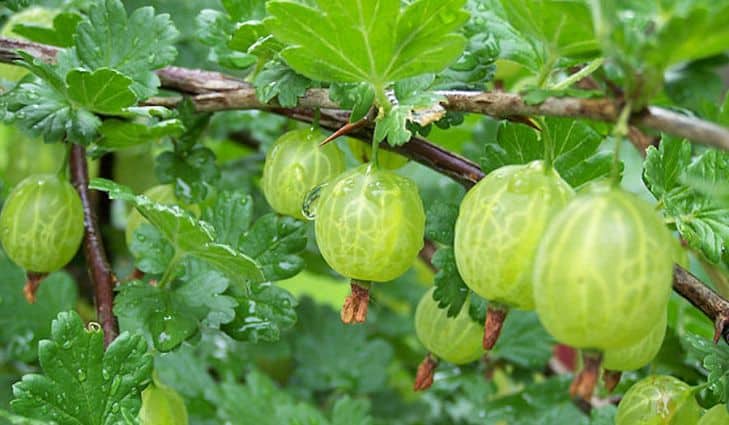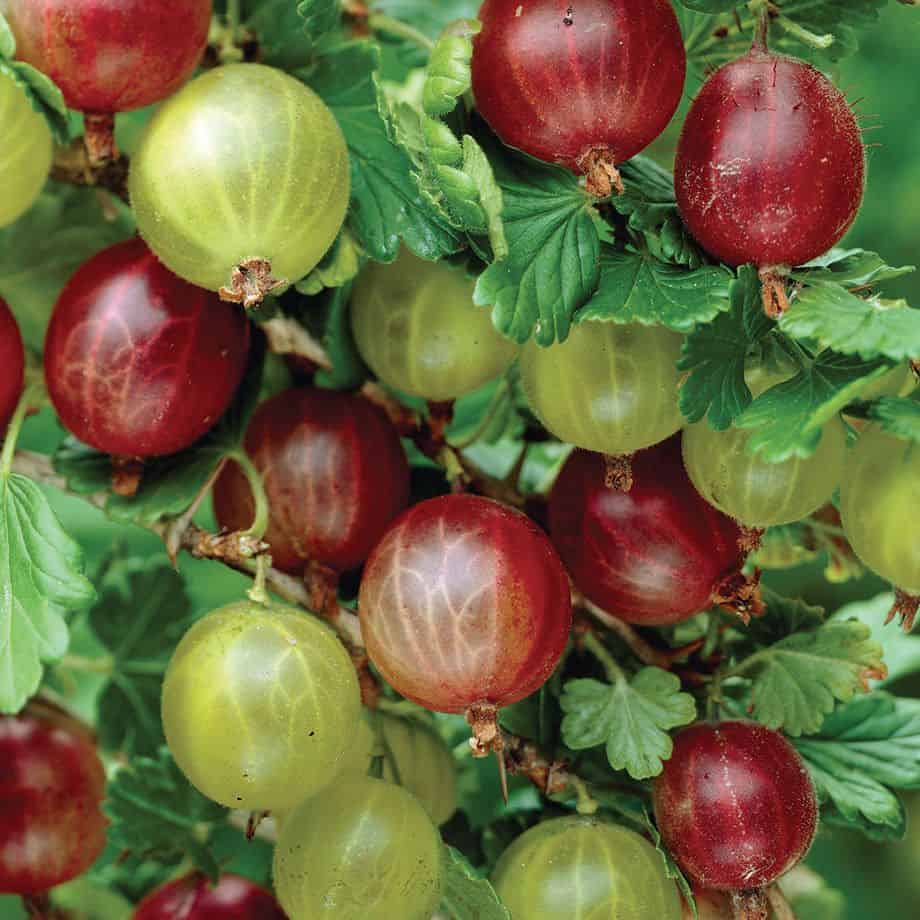
In my family, gooseberries provided everyone with a job: I grew and harvested them, my father topped and tailed them, and my mother turned them into mouth-watering pies and jam. Often thought of as quintessentially English, gooseberries aren’t mentioned in any British documents until the late 13th century, when King Edward I’s fruiterer had bushes imported from France. Their popularity steadily increased, reaching its zenith with the Victorians, who delighted in gooseberry shows and competitions: so much so that Charles Darwin became interested in how a fruit — formerly no larger than a pea — could swell to the size of a small apple in such a relatively short time frame.
Members of the genus Ribes and closely related to currants, two types of gooseberries predominate: the European species (R. uva-crispa), which is native to the Caucasus Mountains and has lethally sharp spines, produces large, delicious fruit but is rather prone to mildew; and the North American species (R. hirtellum), which has fewer thorns and good mildew resistance, but smaller, tarter berries. Most of the cultivars we grow today are a complex mix of these two species — attempts by breeders to secure the best of both worlds.
Gooseberries are one of the easiest fruits to cultivate successfully, and individual bushes are usually productive for at least 15 years. They can be grown in most kinds of soil; left unpruned they’ll reach a mature height and width of five feet (1.5 m), and are solidly hardy to Zone 3. Although the shrubs themselves won’t win any beauty pageants, they can be strategically placed among large, flowering perennials or mixed in with other small, woody plants and trees so they don’t become a focal point.
Planting pointers
In spring, choose a sunny site with good air circulation (to discourage disease), remove any weeds and dig a planting hole twice the width of the root ball, mixing in plenty of composted manure or other organic fertilizer with the topsoil. Leave three feet (1 m) between bushes. Each plant will bear about 2¼ pounds (1 kg) of fruit at maturity, so although they’re self-fertile, one to three bushes are usually enough for most households. Set the plants one inch (2.5 cm) deeper than they were growing in their pots, firm the soil around them and water in well; mulch with a two-inch (5-cm) layer of shredded leaves, clean straw or other organic matter. To stimulate new growth, prune at planting time so individual branches are between four and six inches (10 and 15 cm) long, and remove blossoms that set during the first spring to direct the plant’s energy toward establishing a strong root system.
My pruning advice
Gooseberries fruit best on two- or three-year-old wood. To achieve this, I break all the rules about pruning in late winter when the plants are dormant, and prune at the same time as I harvest, removing 25 per cent of the fruiting branches. This makes collecting berries faster (and less prickly) by opening up the framework for easy access. Using this method, you can control the height and width of the plant while completely rejuvenating it every four years. Other yearly maintenance involves adding fresh compost or manure and leaf mulch around the base of each plant in spring and keeping the area weeded; additional watering may be required during dry spells while fruit is ripening.
Disease and insects
The worst that can be said of gooseberries is that they — along with all members of the Ribes genus — are alternate hosts of white pine blister rust. It does little harm to Ribes species, but the rust can kill five-needle pines (eastern white, bristlecone, Swiss stone and limber pines, among others), so avoid planting gooseberries within 1,000 feet (300 m) of susceptible trees.
The best defence against mildew is to plant resistant cultivars; sulfur sprays are useful before and after bud break (follow package directions), as is a baking soda spray (1 tbsp./15 mL baking soda plus 1 tbsp./15 mL soybean oil in one gallon/4.5 L of water, agitated), although both need to be reapplied after rain. Prune out and destroy infected shoot tips in late winter.
Copper-based fungicides (e.g., Bordeaux mixture) are useful for treating occasional leaf spots due to anthracnose. Clearing up fallen leaves in autumn is also key to controlling the disease.
Imported currant worm (currant sawfly), which attacks just as the leaves have opened fully, strips plants almost bare. Hand-pick or use an organic insecticide at the first sign of damage; there are often two generations per season.

Great gooseberry cultivars
Usually sold as one-year-old plants at garden centres, gooseberries begin full production by age three. Harvesting usually lasts two to three weeks.
‘Captivator’
Bred in Ottawa by Agriculture Canada (now Agriculture and Agri-Food Canada) and released in 1935, ‘Captivator’ bears sweet, pink to red berries in midsummer on an almost thornless, mildew-resistant bush.
‘Hinnomäki Red’
Introduced in the 1990s by the Agricultural Research Centre in Finland, ‘Hinnomäki Red’ bears sweet, medium-sized, red fruit on a spiny, mildew-resistant shrub. The closely related ‘Hinnomäki Yellow’ bears large, golden yellow fruit in early summer and also has good mildew resistance.
‘Invicta’
Introduced in 1981 by East Malling Research in the U.K., this high-yielding cultivar bears large, yellow fruit (up to almost six grams per berry) in early summer on a vigorous, spiny bush with some resistance to mildew.
‘Jahn’s Prairie’
Selected from a native population of hawthorn-leaved gooseberries (R. oxyacanthoides) near Red Deer, Alta., by Dr. Otto Jahn in 1984, and released jointly by AgCan and the USDA. Large, dark red fruit on spiny, upright bushes that show extraordinary resistance to mildew, leaf spot and white pine blister rust.
‘Pixwell’
A cultivar that has stood the test of time, ‘Pixwell’ was released in North Dakota in 1932. Almost thornless, it bears pale green fruit that ripen to a deep pink blush on vigorous, mildew-resistant bushes; excellent for baking and preserves.
Tixia (‘Rafzvicta’)
A new cultivar from Peter Hauenstein of Rafz, Switzerland; the original cross was made in 1990 with ‘Invicta’ as the female parent. Tixia bears large, bright red fruit in midsummer; the upper shoots are virtually thorn-free (one-year-old shoots have a few, relatively soft thorns). Xenia (‘Rafzuera’), also bred by Hauenstein, bears dark red fruit and ripens earlier, while sporting the same thorn-free shoots.
Gooseberries are good for you
1 pound (450 kg) of raw fruit contains:
- Calories 178
- Protein (g) 3.6
- Fat (g) 0.9
- Carbohydrate (g) 44
- Calcium (mg) 100
- Phosphorus (mg) 127
- Iron (mg) 2.3
- Vitamin A (IU) 1,330
- Vitamin C (mg) 149









Interesting. I’m lucky that our gooseberries are growing on the roof, so birds are our chief concern. That said, I remember growing up and never seeing raccoons or any other creature paying them attention (other than occasional worms burrowed in the ripe fruit).
Where can I get the seeds please to send it to me…
[email protected]
We have a gooseberry bush but the critters that visit our yard always beat us to the fruit. We keep checking for ripeness and just when we think the berries will be ready in a couple of days, the next day they are all gone.
I love my gooseberries and so do the racoons. Every year I do battle with them and find that I just cannot leave the berries on the bush until ripe. Thankfully , they continue to ripen and turn red.
It wouldn’t be so bad if the coons ate them, but all they do is pull them off the bush and just suck out the juice leaving a sticky mess behind. And they damage the bush trying to get at them as well.
I use gooseberries to extend fruits, such as raspberries and blackcurrants, when making jam. Combined with these stronger fruits, I find that you can’t really taste the gooseberries.
Hello Carol and Georgia,
I’m surprised (and sorry) to hear about your critter problems. Gooseberries are not usually at the top of a raccoon’s menu since the unripened fruits are quite sour–but as we all know, if raccoons are hungry enough, they’ll eat almost anything.
I would suggest using a physical barrier (such as chicken wire or lightweight welded fencing wire attached to hefty 1″ x 1″ wooden garden stakes) to form a “cage” around the bush(es). This could be put in place as the berries begin to ripen, and then removed after harvest. In other words, it would only need to be in place for about two weeks.
I also think you’ll find that the fruit has more flavour if it’s allowed to ripen on the bush, although flavour is always cultivar-, weather- and soil-dependent. Hope that helps and best of luck this year!